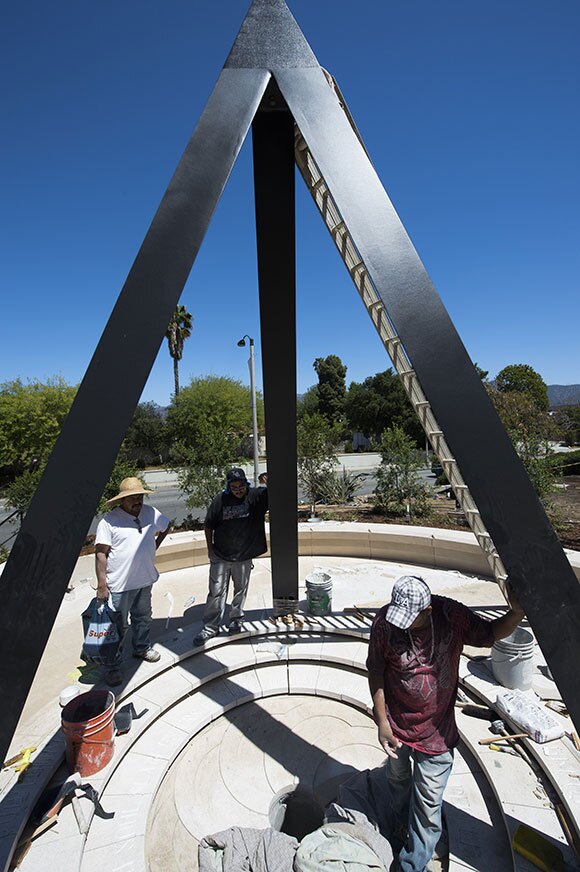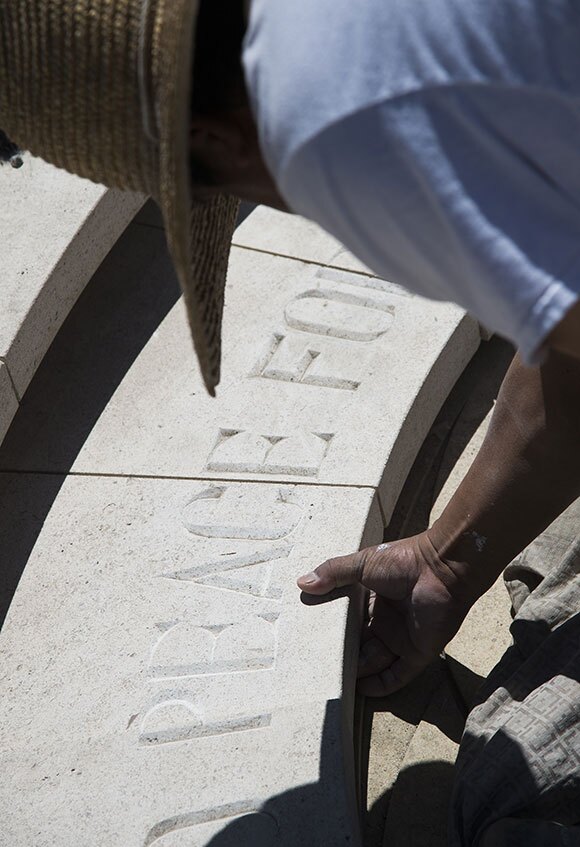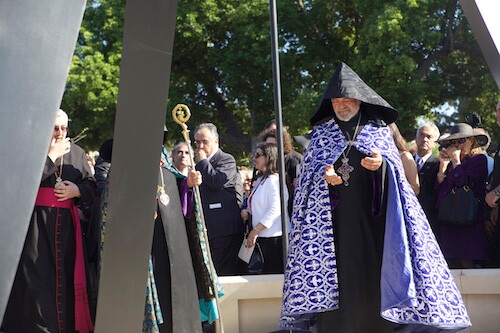Subtle Commemoration: Pasadena's Armenian Genocide Memorial

In the northeast corner of Memorial park -- the quiet and the less accessed side -- where the park's original 1945-built stair entrances and ramps give way to Walnut Avenue, the new Armenian genocide memorial structure activates a portion of the park that had been bare since late 2013 when wind storms in the area felled three 75-year-old oak trees. In the stark absence of the historic trees, city leaders saw opportunity for a new monument in the park, which is also home to memorials honoring Civil war and Vietnam war veterans. April 24th marks the significant 100-year anniversary of the Armenian genocide, and in Pasadena's Memorial park, the Armenian community there will gather at the just-unveiled memorial to the 1.5 million Armenians killed by the Ottoman Turks between 1915 and 1923.
Spearheaded by the Pasadena Armenian Genocide Memorial Committee beginning in 2013, the committee held a 2-stage design competition which included a handful of student proposals from an Art Center College of Design studio (taught by professor James Meraz) dedicated specifically to the design of the Pasadena memorial. A 25-year-old student at Art Center at the time, Catherine Menard's entry won the competition.
Menard spent a large portion of her design process setting the conceptual groundwork by researching the Armenian genocide through photo documentation, written personal accounts and other archival materials. The memorial, simultaneously a beacon and silhouette, abstracts the symbol of the gallows (used to hang Armenians during the genocide years). It is what one sees first approaching the memorial from the lower part of the park, "but the gallows imagery was too austere, too glorified," explains Menard, "so it is anchored by the eternity symbol in the well below." As one enters the seating area surrounding the black skeleton of the "gallows," the eternity symbol's series of interlocked and overlapping circles are revealed like waves etched in limestone. Every 21 seconds, a water drop falls from the gallows to the well beneath, dropping 1.5 million "tears" each year.

The project team included local architecture office Moule & Polyzoides, who developed the construction documents and coordinated the construction team in a tight three-month schedule to ensure the project's readiness for late April's centennial anniversary. Speaking to the cooperative spirit of the project overall and the generousness of the Pasadena City Council and Planning department in its realization, Menard called it, "possibly the easiest a project to be ushered through the planning process in the history of the city of Pasadena."
At a recent reception and unveiling of the memorial -- a week before the official centennial anniversary -- dignitaries, religious and community leaders, and over 1,000 members of the Armenian community from across the southland came to pay respects and dedicate the monument.

"My father was three days old when his father and brother went out to the market and they never came back," said 77-year-old Sona Avalyan at the dedication ceremony, "Every family here has a story like that." She gave a big sigh and raised her eyes up and down the pointed steel pyramid at the center of the memorial. "This is so important to us."
Mary Berberian-Nalbandian, a resident of Pasadena, had a son and daughter participating in the days events, she said she had a sneak peak at the memorial already, "as we were driving down Walnut to the post office the other day." She said, "the monument we have in Montebello is a little too big for my taste," she said, referring to the 75-foot tall memorial in Bicknell Park by architect Hrant Agbabian, constructed in 1967 in remembrance of the 50th anniversary of the genocide. "This one is quiet -- subtle. Subtle is sometimes a more powerful statement."

More than any other building project received by the public at large, the public as an audience is always more engaged in the creation of memorials. The aestheticization and manifesting of a tragedy or memory in physical form is more thoughtfully considered, perhaps even debated, and contested once presented to a community. Most recently, the setbacks with Frank Gehry's Eisenhower memorial on the national mall in Washington D.C., which has been in a back-and-forth limbo of redesigns since 2013, speak to this (some critics have described Gehry's proposed series of metal mesh screens as the looking like "scrunched-up brown bags"). More famously, Maya Lin's low-lying and somber Vietnam memorial in Washington, interpreted by many veterans as offensive and diminishing of their service when its design was unveiled in 1981, was described in an editorial at the time as "a black scar, in a hole, hidden as if out of shame."
Pasadena's new Armenian genocide suffered only a minimum amount of controversy when another Armenian community group, who had outlined a design prior to the Pasadena Armenian Genocide Memorial Committee's in 2011, scheduled a competing anniversary ceremony in the city. But if attendees at the unveiling were aware of the rival design, none mentioned it. Feeling proud of the process, the memorial, and its design team, any controversy around the debated design team was only vaguely mentioned, in the opening remarks and dismissed when speaker Dr. Bernard Melekian assured the crowd designer Catherine Menard had "listened to the voices in the graveyard" as she generated the concept of the design.
The question of who holds ownership of a memory is not lost on Menard, "I believe there is a collective ownership of memory, and certainly in the case of the Armenian community, whose history and suffering has been systematically and strategically stomped out, there is an extremely strong collective ownership of their memory which is almost synonymous with their identity." Says Menard of her role as designer "Certainly there is artfulness and [that] could be ownership over how this experience is harvested and interpreted; but I strongly believe I own everything and nothing. I'm a steward of this memory."
Local architect Stefanos Polyzoides says of the public reception of the monument, "There's a lot of good will for this project. It's prominent and takes a strong position -- and it's beautifully sited," says Polyzoides. "I was there about 10 p.m. the other night, and there was a young family, just sitting silently in its presence." He says, "On one hand it is a memorial to the genocide, but it is also a monument to tolerance that touches all people in all places." He adds, "And it's a nice place to be."